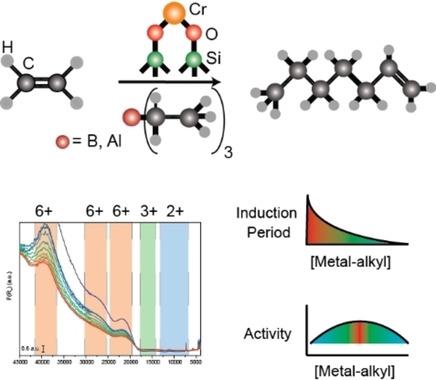当前位置:
X-MOL 学术
›
ChemPhysChem
›
论文详情
Our official English website, www.x-mol.net, welcomes your
feedback! (Note: you will need to create a separate account there.)
Tuning the Redox Chemistry of a Cr/SiO2 Phillips Catalyst for Controlling Activity, Induction Period and Polymer Properties.
ChemPhysChem ( IF 2.3 ) Pub Date : 2020-07-06 , DOI: 10.1002/cphc.202000488 Maarten K Jongkind 1 , Theo van Kessel 2 , Marjolein E Z Velthoen 1 , Nic Friederichs 2 , Bert M Weckhuysen 1
ChemPhysChem ( IF 2.3 ) Pub Date : 2020-07-06 , DOI: 10.1002/cphc.202000488 Maarten K Jongkind 1 , Theo van Kessel 2 , Marjolein E Z Velthoen 1 , Nic Friederichs 2 , Bert M Weckhuysen 1
Affiliation

|
The Cr/SiO2 Phillips catalyst has taken a central role in ethylene polymerization ever since its discovery in 1953. This catalyst is unique compared to other ethylene polymerization catalysts, since it is active without the addition of a metal‐alkyl co‐catalyst. However, metal‐alkyls can be added for scavenging poisons, enhancing the catalyst activity, reducing the induction period and altering polymer characteristics. Despite extensive research into the working state of the catalyst, still no consensus has been reached. Here, we show that by varying the type of metal‐alkyl co‐catalyst and its amount, the Cr redox chemistry can be tailored, resulting in distinct catalyst activities, induction periods, and polymer characteristics. We have used in‐situ UV‐Vis‐NIR diffuse reflectance spectroscopy (DRS) for studying the Cr oxidation state during the reduction by tri‐ethyl borane (TEB) or tri‐ethyl aluminum (TEAl) and during subsequent ethylene polymerization. The results show that TEB primarily acts as a reductant and reduces Cr6+ with subsequent ethylene polymerization resulting in rapid polyethylene formation. TEAl generated two types of Cr2+ sites, inaccessible Cr3+ sites and active Cr4+ sites. Subsequent addition of ethylene also revealed an increased reducibility of residual Cr6+ sites and resulted in rapid polyethylene formation. Our results demonstrate the possibility of controlling the reduction chemistry by adding the proper amount and type of metal‐alkyl for obtaining desired catalyst activities and tailored polyethylene characteristics.
中文翻译:

调节 Cr/SiO2 Phillips 催化剂的氧化还原化学以控制活性、诱导期和聚合物性能。
自 1953 年被发现以来, Cr/SiO 2 Phillips 催化剂在乙烯聚合中一直发挥着核心作用。与其他乙烯聚合催化剂相比,该催化剂是独特的,因为它无需添加金属烷基助催化剂即可保持活性。然而,可以添加烷基金属来清除毒物、增强催化剂活性、缩短诱导期并改变聚合物特性。尽管对催化剂的工作状态进行了广泛的研究,但仍未达成共识。在这里,我们表明,通过改变金属烷基助催化剂的类型及其用量,可以定制 Cr 氧化还原化学,从而产生不同的催化剂活性、诱导期和聚合物特性。我们使用原位紫外-可见-近红外漫反射光谱(DRS)来研究三乙基硼烷(TEB)或三乙基铝(TEAl)还原过程中以及随后的乙烯聚合过程中的Cr氧化态。结果表明,TEB 主要充当还原剂,通过随后的乙烯聚合还原 Cr 6+,从而快速形成聚乙烯。TEAl产生两种类型的Cr 2+位点,不可接近的Cr 3+位点和活性Cr 4+位点。随后添加乙烯还表明残余 Cr 6+位点的还原性增加,并导致聚乙烯快速形成。我们的结果证明了通过添加适当数量和类型的烷基金属来控制还原化学以获得所需的催化剂活性和定制的聚乙烯特性的可能性。
更新日期:2020-07-06
中文翻译:

调节 Cr/SiO2 Phillips 催化剂的氧化还原化学以控制活性、诱导期和聚合物性能。
自 1953 年被发现以来, Cr/SiO 2 Phillips 催化剂在乙烯聚合中一直发挥着核心作用。与其他乙烯聚合催化剂相比,该催化剂是独特的,因为它无需添加金属烷基助催化剂即可保持活性。然而,可以添加烷基金属来清除毒物、增强催化剂活性、缩短诱导期并改变聚合物特性。尽管对催化剂的工作状态进行了广泛的研究,但仍未达成共识。在这里,我们表明,通过改变金属烷基助催化剂的类型及其用量,可以定制 Cr 氧化还原化学,从而产生不同的催化剂活性、诱导期和聚合物特性。我们使用原位紫外-可见-近红外漫反射光谱(DRS)来研究三乙基硼烷(TEB)或三乙基铝(TEAl)还原过程中以及随后的乙烯聚合过程中的Cr氧化态。结果表明,TEB 主要充当还原剂,通过随后的乙烯聚合还原 Cr 6+,从而快速形成聚乙烯。TEAl产生两种类型的Cr 2+位点,不可接近的Cr 3+位点和活性Cr 4+位点。随后添加乙烯还表明残余 Cr 6+位点的还原性增加,并导致聚乙烯快速形成。我们的结果证明了通过添加适当数量和类型的烷基金属来控制还原化学以获得所需的催化剂活性和定制的聚乙烯特性的可能性。









































 京公网安备 11010802027423号
京公网安备 11010802027423号